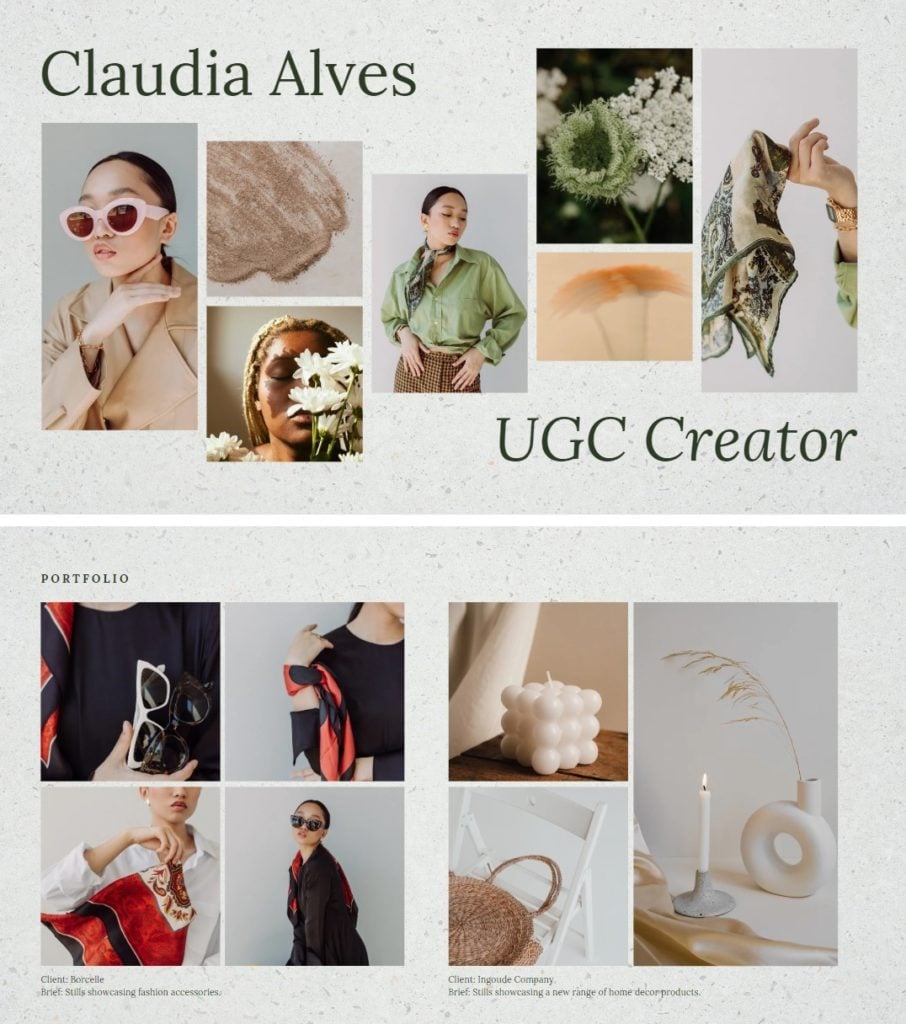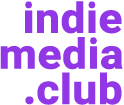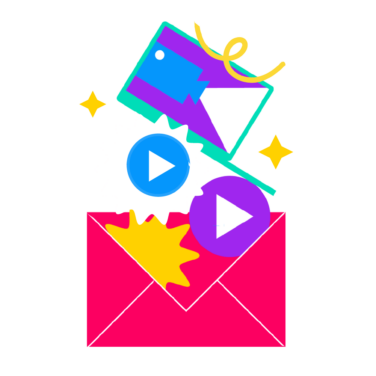You no longer need millions of followers to pull in thousands of dollars each month as a social media content creator. Instead, digital content creators are specializing as UGC creators.
UGC is not just a buzzword—it's an integral part of digital content marketing. From TikTok to Instagram, UGC creators are changing how we all do business and engage with our audiences.
According to creators like @ugcang, it’s possible to pull in a full-time income as a UGC creator, and all you need is a decent camera, good lighting, and some creative entrepreneurial spirit.
This guide will cover everything you need to know about becoming a freelance UGC creator: How it works, what kind of content to create, what is expected of a creator, and even some tips on building your portfolio.

What is User-Generated Content?
In the simplest terms, user-generated content (UGC) is marketing content organically created by individuals rather than an in-house content production team. Think of unboxing videos on TikTok or YouTube or tagging a brand on your Instagram post.
What is the Difference Between UGC and Influencer Marketing?
The answer lies in the creators themselves. While influencer marketing seeks to tap into the pre-built audience of a famous personality, UGC is made by the average consumer and leverages social proof to gain popularity.
Influencers can be hard to relate to, as part of their spectacle and influence comes from their lavish lifestyles. On the other hand, UGC creators appear just like you and me, making it much easier to place ourselves in their shoes and trust their opinions on products and services.
What Does a UGC Creator Do?
As a UGC creator, your goal is to create content that feels natural and user-generated, despite being sponsored by a brand.
This is done through content you usually wouldn’t expect from a brand, such as comedic skits, vlogs, or personal stories.
For example, you wouldn’t see UGC with phrases like “best-in-class” or “formulated by professionals for professionals.” Instead, the skill of UGC creators lies in their ability to use their authentic voice to spark interest in a product or service.
Here are some popular ways we see UGC creators do this:
- Unboxing videos
- “Get Ready with Me” (GRWM)
- Daily vlogs or “Day in the Life”
- Hands-on product reviews and testimonials
- Relatable humor and memes
- Skits
- Educational tutorials and tips
- “Outfit of the Day” (OOTD)
How Do Brands Benefit From UGC Creators?
Consumer interest in highly-curated, branded content has plummeted. Instead, quirky TikToks filmed by creators in sweatpants have the power to sell out a product line overnight.
This is where the hyper-accelerated growth in UGC comes from and why many brands are shifting to a UGC-focused content marketing strategy.
You might think that partnering with a UGC creator would be too expensive, but the truth is that managing a full content marketing team requires much more time, effort, and cost in the long run.
Instead, hiring specialized freelance UGC creators allows a brand to:
- Reduce content production costs.
- Leverage the platform-specific skills and knowledge of individual creators.
- Save time by managing fewer team members.
- Tap into a wider pool of creatives.
How to Get Started as a UGC Creator (in 3 Steps)
1. Identify your industry
Before making any content, you first need to understand your target audience. Start by asking yourself the following questions to identify your industry focus:
- Who are you making content for?
- Which brands would you love to work with?
- What are you passionate about?
For example, list your favorite outdoor equipment brands if you’re passionate about hiking and camping. Then, consider common pain points and struggles you experience while performing these activities and how you would create content to solve them.
2. Create content for that industry
Whether your chosen industry is general (outdoors) or hyper-targeted (new mothers struggling with weight loss), your next step is to make content for that audience.
This is where you must decide on the type of content you want. Would you prefer to shoot static content, such as product photos and lifestyle shots? Or are you more interested in short-form videos for platforms like TikTok and Reels?
Look up examples by other content creators in your niche to get an idea of what performs well in that industry. Then practice creating content on a personal account, like a TikTok account dedicated to UGC creation and short-form video content.
3. Showcase your content in a portfolio
Your portfolio should showcase your best work in a way that tells a story about who you are as a creative.
Remember: The goal of UGC is to produce authentic content. Frame your entire portfolio under the question: how will your original content connect with real people and bring personality to a brand?
One of the best and easiest tools to create a UGC portfolio is Canva. Create a free Canva account and use a premade portfolio template, like the one below, to get started.

How Do You Approach a Brand to Get a UGC Job?
If you want to get hired as a UGC creator, the first step is to approach brands directly. You can do this through email or social media platforms like LinkedIn, Instagram, or Twitter.
Reaching out to a brand for collaboration is called “pitching” or “cold outreach.”
Here’s a basic structure to follow in your pitch:
- Open with a heartfelt personalized note. Explain your history with the brand products or a specific marketing campaign you loved.
- Include a short sentence detailing how your content creation will benefit the brand.
- Insert a link to your portfolio and other essential contact details.
- Thank the reader for their consideration.
My best advice is to create a spreadsheet with all the brands you would love to work with. Keep track of which ones have replied and who hasn’t yet responded—and don’t forget to follow up!
To expand your reach as a UGC content creator, I also suggest:
- Creating an account on Upwork.
- Posting UGC content examples on LinkedIn.
- Joining Fivver’s freelance marketplace.
Examples of UGC Creators on Social Media
Watching content produced by other UGC creators, and learning from their journey, is one of the best ways to understand exactly what it takes to make it as a UGC creator.
Here are some of my favorite sources for UGC tips and inspiration:
@ugcang on TikTok
@ugcang How to start UGC today! Step-by-step! Sign a deal this week 💸👀💌 #ugccreator #ugc #ugchowto #ugcang #ugcvideos ♬ LDN - Lily Allen
UGC Ang is one of the best-known UGC creators on TikTok. She shares everything you need to know about UGC, from video walkthroughs on portfolio building to examples of high-quality UGC videos. If you’re looking for inspiration and tips on how to get started, her entire account is a fantastic resource.
@mike.rama on TikTok
@mike.rama Here’s how much to charge for UGC. What do you think about the average UGC price? Check this out to learn how much to charge as a UGC Creator and see what other creators rates are. #ugc #ugccreators #ugcprice #ugcrates #ugcaverageprice #brandsmeetcreators #BMC #contentcreators #ugcneeded ♬ Epic Music(863502) - Draganov89
Mike Rama is a digital content marketer who makes informative videos on all things related to the fast-growing creator economy.
His content provides insights into UGC, including pricing data and outreach examples, and explores marketing strategies and sales tactics to help you scale your UGC business.
@patriizzle on Instagram & TikTok
@patriizzle in the city 🫶🏼🫶🏼🫶🏼
♬ drake.greece. - dr.aux ♒︎👨🏽⚕️
On the surface, this creator may look like just another influencer, but all her content is an example of UGC. Patriizzle, or Trish, does an outstanding job of using daily vlogs and trending sounds to showcase products in a clever way—a common form of UGC.
See if you can spot the product she’s representing in the video above!
Best Tools to Create User-Generated Content
I mentioned before that all you need to create UGC is a phone camera, which is mostly true. However, to edit and package your final content for brands, you’ll need a few extra tools in your belt.
CapCut
CapCut is a free video editing app that has become a favorite for short-form video creators. The tool was created by Bytedance, the same company that owns TikTok, and has cross-platform compatibility with TikTok.
CapCut includes all the necessary effects to make your content appear native to TikTok, including fonts, voiceovers, and auto-captions.
The best thing about CapCut is that you can access it via desktop. A desktop video editor is handy for UGC creators who need to edit lots of content daily—it sure beats editing on a tiny phone screen.
Adobe Lightroom
If your goal is to use your photography skills for UGC, then I highly recommend familiarizing yourself with Adobe Lightroom if you haven’t already.
Lightroom is the less intimidating cousin of Photoshop. In Lightroom, you can edit your product shots to look their best, including exposure, saturation, temperature, and more.
For quick and easy edits, Lightroom also comes packed with pre-set filters for every mood and style. You can purchase custom filters your favorite photographers create to mimic their style if you like.
Canva
Canva is another free online resource that will become your best friend as a UGC creator. While you might not be using Canva to create the UGC, you will need it to package and present your content to brands.
The main reason to use Canva is for outreach materials: Think portfolios, your brand logo, rate cards, etc. You can even make a complete website design through Canva, which is a fantastic option if you aren’t ready to purchase a domain.
It's Time to Get Out There and Make Content!
Now that you've read this guide, it's time to get out there and make content.
- Make a list of ideas. Think about what you're interested in filming—can you make a list of 100?
- Start making content, even if it's not perfect at first. The first few videos will be rough, but you’ll improve with each piece of content you create.
- Drop us a comment below to let us know if this guide was helpful. Did we skip anything important?
Before you go, don’t forget to subscribe to the Indie Media Club newsletter for more golden nuggets on the latest trends in digital content creation.


